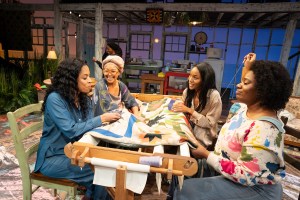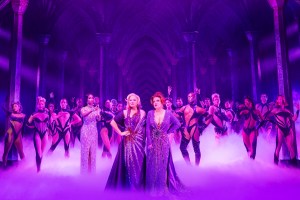

(© Tristan Fuge)

(© Tristan Fuge)

(© Tristan Fuge)

(© Tristan Fuge)

(© Tristan Fuge)

(© Tristan Fuge)


The two-story building at 1552-1554 Broadway and 46th Street in Manhattan opened in the 1920s as an upscale I. Miller store, a national chain that specialized in shoes-for-showbiz, from dance to opera to the big screen. Since it is still intact –- and abandoned until next autumn — theater fans can currently gaze up at SHOW FOLKS’ ornate stone statues of the world-famous grande dames of drama, film, and opera that decorate its facade: Ethel Barrymore as Hamlet‘s Ophelia, representing theater; Mary Pickford in 1921’s Little Lord Fauntleroy, representing classic Hollywood; Marilyn Miller in the film Sunny, representing musical comedy; and Rosa Ponselle in the 1927 revival of Bellini’s Norma at the Metropolitan Opera House, representing opera. The sculptures, commissioned for the building, were designed by Alexander Sterling Calder.
In the book Forgotten New York: The Ultimate Urban Explorers Guide to All Five Boroughs, Kevin Walsh explains how these actresses were chosen:
“In 1927, the I. Miller company took the public vote to determine the most popular theater actresses of the day, with the idea of placing statues of them above their new seventh avenue store. The results came in, and sculptor Alexander Sterling Calder was chosen to depict them in some of their most famous roles.”
The business of making shoes for leading ladies is much different than the Al Bundy shoe business.
“It comes down to the construction,” said Alicia Rossi, the manager of LaDuca Dance Shoes, today’s premiere company for dance and theater kicks. “The main difference is flexibility: movement through the foot. The construction also depends on the choreographer and dancer. We do custom shoes for each show and each performer, because in this industry your feet are your tools. Regular shoes are just to get around, but they’re not for self expression.”
LaDuca, however, has expanded to sell high-end heels for non-show-folks. I. Miller made a similar expansion in the 1950s, when they hired Andy Warhol as the company’s chief illustrator, before he became a household-pop-artist. Warhol was assigned, essentially, to modernize and rebrand the I. Miller Company. Through Warhol’s advertisements, I. Miller tried to implant the idea that they were not simply a purveyor of theater shoes, but an entire lifestyle for women. (Mr. Isaac Miller, Don Draper is holding on line one.)
Warhol was successful. The shop thrived until the 1970s. Then, the building went downhill.
In the 1990s, the organization Save the Theaters tried to make 1552-1554 Broadway a historical landmark, but the city denied it landmark status. It became a billboard-plastered T.G.I. Fridays, before real estate mogul Jeff Sutton bought it to the tune of $136.5 million, as a new flagship Express store.
New York City is harsh on the nostalgic, even those who know New York City is harsh on the nostalgic.
At the very least, theater and architecture fans have a year to peep the property before ads plaster over its history, and tourists pour in to buy “Editor jeans.”
So we leave you with these words by Colson Whitehead, from his masterpiece The Colossus of New York:
“No matter how long you have been here, you are a New Yorker the first time you say, That used to be Munsey’s, or That used to be the Tic Toc Lounge. That before the internet cafe plugged itself in, you got your shoes resoled in the mom-and-pop operation that used to be there. You are a New Yorker when what was there before is more real and solid than what is here now.”
Sigh.












